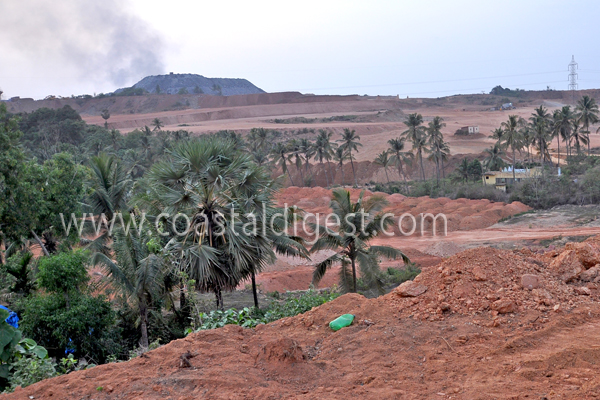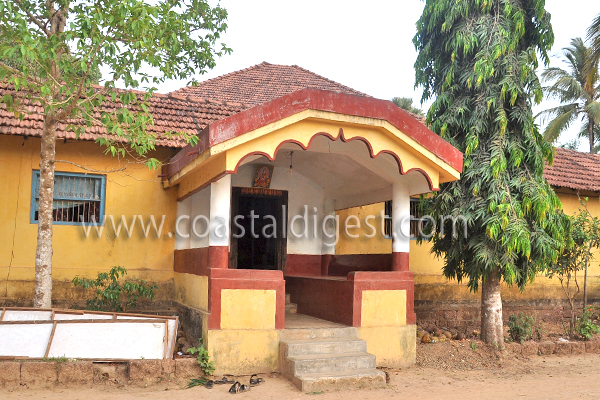
“I haven’t been able to sleep for the past two days” is what 12 year old Bhavya Shetty says holding her ear which she says was mercilessly twisted by men representing the Mangalore Special Economic Zone Ltd. (MSEZL) who came in with JCBs and bulldozers to carry out work on land belonging to the inhabitants of Nallidadi Guttu in Bajpe on May 25.
“They twisted my ear and threw me away. All we did was ask them why they were laying their hands on our elders”, she says.
The ecologically rich landscape around Nallidadi Guttu has already come under the radar of MSEZ and on May 25, its personnel announced their arrival with JCBs around the Guttu to carry out their work. “About eight of us were playing when they came. When our elders went to speak to them, they laid their hands on them. We went and asked as to why they were beating our elders but Krishna Mayya (MSEZ official) twisted my ear and threw me away. My ear is still paining and I haven’t been able to sleep for two days”, says little Bhavya.
Her 13 year old cousin Nirikshit Shetty had to face the music too. “They twisted my hand and threw me away” says Nirikshit holding his fractured arm. Ujwal, another of their cousins was also mercilessly treated by MSEZ officials, the kids say. “He has gone down with fever after the incident”, says Bhavya.
It was vacation time for Bhavya who had come down to her ancestral home from Mumbai. But MSEZ officials ensured that her holidays this summer would be remembered by her for wrong reasons. The child recalls every bit of what transpired before her on May 25. “They dared our people to stop them from acquiring our lands. They told us that they will get JCBs soon and demolish our Guttu, even if it means breaking our limbs and burying us under the same mud heap”, Bhavya says.
The entire Nallidadi Guttu rose in revolt when Laxman Chowta, the head of the Guttu, was attacked by MSEZ officials. “He is our spiritual head. But naturally when someone does something to him, we will not be able to tolerate it. When he was attacked, we all went to his aid and so did the children. But they showed no mercy” says Kishor Shetty, Bhavya’s uncle.
No one was spared on the day says Mr. Kishor. “They attacked me too. I was hospitalized later that day. I still have a swollen neck and my eyes are still paining. They did not spare our women either, warning them that they would cut them into pieces. They behaved rudely with them. On that day, not many from our family were present here. What can you do when they bring some 200 goondas along? We cannot take them on all by ourselves. They were rowdies and you could make out in the way they were speaking to our people. Their language said it all. Besides, if the MSEZ officials were really concerned about security they should have brought police personnel along with them, not goondas”, says he.
Laxman Chowta, the spiritual head of the Guttu was targeted the most. As a spiritual head of the Guttu, he commands respect from his people and it showed in his concern for making preparations for the ‘Nema’ that was scheduled to be held the following day. He came back from the hospital at night and made sure that everything was in place for the ‘Nemotsava’.
The Nallidadi Guttu consists of 18 houses inhabited by about 300 people, all of whom belong to the same family. “We are all relatives and are one family. Our Guttu has a tradition and history of more than 800 years. We hold a grand ‘Nemotsava’ every year. One of our traditions is mass feeding for people who attend our ‘Nemotsava’. We hold mass feeding programmes thrice every year during Aati, Deepavali and Chavali Nemostava festivals”, says Mr. Chowta. In fact ‘Chowta’ is a title given to the chief of the Guttu. The Nallidadi Guttu household also has a tradition wherein it is mandatory for all the families to have food together under one roof once in a year.
The ‘Daiva’ that people of the Guttu believe in, had even warned MSEZ officials once, Mr. Chowta says. “Some MSEZ officials had attended one of our rituals and the ‘Daiva’ had warned them asking them to stay away from our land. But they said they are just employees of the company and left the scene along with the ‘prasad’”, says he.
The MSEZ officials had cheated them, Mr. Chowta says. “When A J Pai was in-charge, he had told us that only some of our lands would be acquired by the MSEZ. We believed in his oral assurance and did not take it in writing”, Mr. Chowta laments.
The responses from elected representatives have been disappointing too, Mr. Chowta says. “We had met Nalin Kumar Kateel and explained to him the situation and he had assured us that he will come for a survey. But he hasn’t been available ever since, neither does he pick our telephone calls. The Chief Minister said he could not directly take a call and advised us to approach Krishna Palemar who has also disappointed us”, says Mr. Chowta. “Palemar is with the MSEZ officials. He told us to even take them on if they get physical assuring that he would be there come what may. If we believe his words and get physical with them, tomorrow we will be behind bars with criminal cases slapped against us and Palemar will not come to our rescue. These elected representatives are not being available as it is. How can we expect them to back us in such situations?” asks Mr. Kishor.
“The authorities claim that our people had given land to them voluntarily. When we demanded an answer from them through an RTI application as to whether they can produce documents in support of the voluntary land hand over, the response we received said that no documents are available at the moment”, Mr. Kishor says.
After all the unpleasant happenings on May 25, Mr. Kishor said a bigger surprised awaited them from MSEZ. “They have registered a case against us saying that we harmed their JCB. Are they out of their senses? How would it have been possible for us to damage their JCB with 200 of their goondas coming at us? Tomorrow they may say our children damaged their JCB!” Mr. Kishor says.
Mr. Chowta and others have however filed a complaint on the assault on them with the Bajpe police. Bhavya and Nirikshit too have submitted a written complaint to Yogesh Dubey, Chairman, National Child Rights Protection Commission who visited Mangalore on May 28.
The advent of MSEZ has spelled doom for people of the Guttu. Chanrdika, one of the ladies who now lives in a rented house following the demolition of her dwelling by MSEZ officials during land acquisition, says she fails to fathom the compensation parameters of the company. “They want to build an industry alright, but for us our agricultural land itself is our factory. We are farmers. We felt our belly burn when their machines pulled down our trees and crops. Do they realize that it takes about ten years for a coconut tree to grow and start bearing fruit? They want to give us a meager compensation and take away our factory, our land on which we do farming, the only thing we know”, says she. Its hard, indeed hard for Ms. Chandrika and others to see their crop lying destroyed along the ground. They see them every day.
After MSEZ work began in the region, the residents of Nallidadi Guttu have been facing other problems as well. “Their heavy vehicles have spoiled the road which was already in bad shape. Mud has been dumped around the region in large quantities and during rains there is bound to be some flooding. Some of the wells have become dirty. Their vehicles keep damaging the electric poles and we are left to face constant power cuts”, says Mr. Kishor.









Photos by Suresh Vamanjoor





Comments
Add new comment